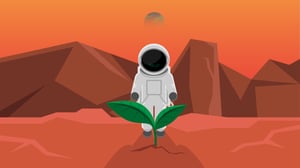Three unknown strains have been identified on the International Space Station orbiting Earth. And they might prove useful for growing plants in extreme conditions (even on Mars).
The International Space Station (ISS) permanently orbiting planet Earth is full of surprises and interesting things to study. As science magazine Frontiers in Microbiology explains, the most recent has seen the discovery – in the space station itself – of three new strains of the Methylobacteriaceae bacterial “family”, which may well prove useful for growing plants during spaceflight, or on other planets.
An article in “Frontiers” (which publishes the magazine) explains: “In order to withstand the rigors of space on deep-space missions, food grown outside of Earth needs a little extra help from bacteria. A recent discovery aboard the International Space Station (ISS) may help researchers create the ‘fuel’ to help plants withstand such stressful situations."
Exceptionally adaptable
The three new strains had never been seen before, and were found in different areas of the ISS on two missions. They have been designated codes IF7SW-B2T, IIF1SW-B5 and IIF4SW-B5. A fourth strain was also identified on the ISS as Methylorubrum rhodesianum, and had already been come across once before, some years ago.
These microorganisms are important because they can fix nitrogen and solubilize potassium, as well as develop toxins to counter antagonist species. They can also survive in conditions which seemingly offer no form of nourishment. All of which are essential processes for developing plants in extra-terrestrial environments: hence why they have greeted with such interest.
The ISS constantly undergoes microbiological analysis and disinfestation to help prevent any contamination hazards for astronauts. But at the same time, populations of microorganisms that manage to survive and develop autonomously are also studied, both inside the Space Station and on the outside walls (observations like this have been carried out for some years now). To date, more than a thousand samples have been collected; many are still waiting to be sent back to Earth for microbiological analysis. But attempts are also being made to build a mini-sequencer of their gene code, to be used in the Space Station itself. This might well provide a faster response.
Close cooperation with NASA
The discovery of three new strains was made by researchers of the University of Southern California and the University of Hyderabad (India). Both work with NASA and specialize in studying life under extreme conditions.
The academics suggested naming the three new strains (and their species) Methylobacterium ajmalii, in honour of Ajmal Khan, one of the world’s leading biodiversity experts.
Given that NASA is planning to take human beings to Mars – and potentially beyond – the US National Research Council’s Decadal Survey recommends that NASA use the International Space Station as a “test-bed for surveying microorganisms”. A broader series of experiments will nonetheless be needed to prove whether this type of bacteria really could prove decisive for space farming.

